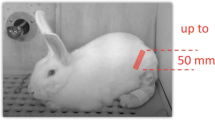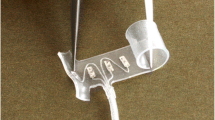Abstract
The chronic effects of a reshaping nerve electrode, the flat interface nerve electrode (FINE), on sciatic nerve physiology, histology, and blood–nerve barrier (BNB) are presented. The FINE electrode applies a small force to a nerve to reshape the nerve and fascicles into elongated ovals. This increases the interface between the nerve and electrode for selective stimulation and recording of peripheral nerve activity. The hypothesis of this study is that a small force applied noncircumferentially to a nerve can chronically reshape the nerve without effecting nerve physiology, histology, or the blood–nerve barrier permeability. Three FINE electrode designs were implanted on rat sciatic nerves to examine the nerve's response to small, moderate, and high reshaping forces. The chronic reshaping, physiology, and histology of the nerve were examined at 1, 7, and 28 days postimplant. All FINEs significantly reshape both the nerve and the fascicles compared to controls. FINEs that applied high forces caused a neurapraxia type injury characterized by changes in the animal's footprint, nerve histology, and the BNB permeability. The physiological changes were greatest at 7 days and fully recover to normal by 14 days postimplant. The moderate force FINE did not result in changes in the footprint or BNB permeability. Only a minor decrease in axon density without accompanying evidence of axon demyelination or regeneration was observe for the moderate force. The small force FINE does not cause any change in nerve physiology, histology, or BNB permeability compared to the sham treatment. An electrode that applies a small force that results in an estimated intrafascicular pressure of less than 30 mm Hg can reshape the nerve without significant changes in the nerve physiology or histology. These results support the conclusion that a small force chronically applied to the nerve reshapes the nerve without injury. © 2003 Biomedical Engineering Society.
PAC2003: 8717Nn, 8719Nn, 8780Xa, 8719Uv
Similar content being viewed by others
References
Dahlin, L. B.Aspects on pathophysiology of nerve entrapments and nerve compression injuries. Neurosurg. Clin. N. Am.2:21–29, 1991.
Delfiner, J. S.Dynamics and pathophysiology of nerve compression in the upper extremity. Orthop. Clin. North Am.27:219–226, 1996.
Dellon, E. S., and A. L. Dellon. Functional assessment of neurologic impairment: Track analysis in diabetic and compression neuropathies. Plast. Reconstr. Surg.88:686–694, 1991.
Gelberman, R., R. Eaton, and J. Urbaniak. Peripheral nerve compression. J. Bone Jt. Surg., Am. Vol.75:1854–1878, 1993.
Gelberman, R. H., et al. The carpal tunnel syndrome. A study of carpal canal pressures. J. Bone Jt. Surg., Am. Vol.63:380–383, 1981.
Larsen, J. O.et al. Degeneration and regeneration in rabbit peripheral nerve with long-term nerve cuff electrode implant: A stereological study of myelinated and unmyelinated axons. Acta Neuropathol. (Berlin)96:365–378, 1998.
Lundborg, G., and L. B. Dahlin. Anatomy, function, and pathophysiology of peripheral nerves and nerve compression. Hand Clin.12:185–193, 1996.
Lundborg, G.et al. The effect of ischemia on the permeability of the perineurium to protein tracers in rabbit tibial nerve. Acta Neurol. Scand.49:287–294, 1973.
Lundborg, G., R. Myers, and H. Powell. Nerve compression injury and increased endoneurial fluid pressure: A “miniature compartment syndrome.”J. Neurol., Neurosurg. Psychiatry46:1119–1124, 1983.
Munger, B. L., G. J. Bennett, and K. C. Kajander. An experimental painful peripheral neuropathy due to nerve constriction. I. Axonal pathology in the sciatic nerve. Exp. Neurol.118:204–214, 1992.
Myers, R. R.et al. The role of focal nerve ischemia and Wallerian degeneration in peripheral nerve injury producing hyperesthesia. Anesthesiology78:308–316, 1993.
Nitz, A. J., J. J. Dobner, and D. H. Matulionis. Pneumatic tourniquet application and nerve integrity: Motor function and electrophysiology. Exp. Neurol.94:264–279, 1986.
Nitz, A. J., and D. H. Matulionis. Ultrastructural changes in rat peripheral nerve following pneumatic tourniquet compression. J. Neurosurg.57:660–666, 1982.
Olsson, Y. Studies on vascular permeability in peripheral nerves. I. Distribution of circulating fluorescent serum albumin in normal, crushed and sectioned rat sciatic nerve. Acta Neuropathol. (Berlin)7:1–15, 1966.
Powell, H. C., and R. R. Myers. Pathology of experimental nerve compression. Lab. Invest.55:91–100, 1986.
Rydevik, B., M. D. Brown, and G. Lundborg. Pathoanatomy and pathophysiology of nerve root compression. Spine9:7–15, 1984.
Rydevik, B., and G. Lundborg. Permeability of intraneural microvessels and perineurium following acute, graded experimental nerve compression. Scand. J. Plast. Reconstr Surg.11:179–187, 1977.
Rydevik, B., G. Lundborg, and U. Bagge. Effects of graded compression on intraneural blood blow. An study on rabbit tibial nerve. J. Hand Surg. [Am]6:3–12, 1981.
Rydevik, B., G. Lundborg, and C. Nordborg. Intraneural tissue reactions induced by internal neurolysis. An experimental study on the blood–nerve barrier, connective tissues and nerve fibers of rabbit tibial nerve. Scand. J. Plast. Reconstr. Surg.10:3–8, 1976.
Steinwall, O., and I. Klatzo. Selective vulnerability of the blood–brain barrier in chemically induced lesions. J. Neuropathol. Exp. Neurol.25:542–559, 1966.
Takahashi, K.et al. Double-level cauda equina compression: An experimental study with continuous monitoring of intraneural blood flow in the porcine cauda equina. J. Orthop. Res.11:104–109, 1993.
Tyler, D. J., and D. M. Durand. A slowly penetrating interfascicular nerve electrode for selective activation of peripheral nerves. IEEE Trans. Rehabil. Eng.5:51–61, 1997.
Zochodne, D. W., and P. A. Low. Adrenergic control of nerve blood flow. Exp. Neurol.109:300–307, 1990.
Author information
Authors and Affiliations
Rights and permissions
About this article
Cite this article
Tyler, D.J., Durand, D.M. Chronic Response of the Rat Sciatic Nerve to the Flat Interface Nerve Electrode. Annals of Biomedical Engineering 31, 633–642 (2003). https://doi.org/10.1114/1.1569263
Issue Date:
DOI: https://doi.org/10.1114/1.1569263




